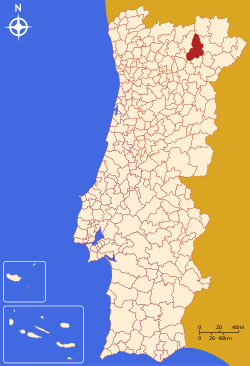Mirandela
| Mirandela | |||
|---|---|---|---|
| Municipality | |||

City Hall
|
|||
|
|||
 |
|||
| Coordinates: 41°29′7″N 7°10′54″W / 41.48528°N 7.18167°WCoordinates: 41°29′7″N 7°10′54″W / 41.48528°N 7.18167°W | |||
| Country |
|
||
| Region | Norte | ||
| Subregion | Alto Trás-os-Montes | ||
| Intermunic. comm. | Terras de Trás-os-Montes | ||
| District | Bragança | ||
| Parishes | 30 | ||
| Government | |||
| • President | José Maria Lopes Silvano (PPD-PSD) | ||
| Area | |||
| • Total | 658.96 km2 (254.43 sq mi) | ||
| Elevation | 301 m (988 ft) | ||
| Population (2011) | |||
| • Total | 23,850 | ||
| • Density | 36/km2 (94/sq mi) | ||
| Time zone | WET/WEST (UTC+0/+1) | ||
| Postal code | 5370 | ||
| Patron | Nossa Senhora do Amparo | ||
| Website | http://www.cm-mirandela.pt | ||
Mirandela (Portuguese pronunciation: [miɾɐ̃ˈdɛlɐ]) is a city and a municipality in northeastern Portugal. The city itself has a population of about 15,000. The population of the municipality in 2011 was 23,850, in an area of 658.96 km². Mirandela is famous for its cuisine, particularly the alheiras. A round of the European Jetski Championship is held on the Tua River every Summer. The city has two campuses of higher education institutions - one belonging to the public Bragança Polytechnic Institute and one belonging to the private Instituto Piaget.
The settlements of Mirandela date back to the pre-historical period, but primarily relate to a period of Roman occupation. During this era, the main settlement of Mirandela was a Roman civitas, known then as Caladunum. There are abundant vestiges of the Roman occupation in Castelo Velho, São Martinho, Mourel and Prado Pequeno, that include copper coins from the reign of Emperor Tiberius. At this time the civitas was located in the region of São Martinho, but there are conflicting references as to the location of the main settlement, and when it was moved. Ernesto de Sales, referenced three documents that localized the Christian village near São Martinho (even as another document in 1258 disputed the existence of the village of Mirandela in or near this region):
It is clear, from the documents of King Denis, at the time when he was elaborating the defenses of the city of Guarda (2 September 1282), the transfer of the town of Mirandela to hilltop of mount São Miguel (where a small hermitage chapel existed at the time) had likely already occurred. This location was easily defendable and dominated the view of the fertile lands and river access.
King Afonso III granted a foral (charter) on 25 May 1250. The magistrate of Mirandela at the time governed a region that included Torre de D. Chama, Frechas, Sesulfe, Nozelos, Vilas Boas, Vale de Asnes and Cortiços.
This document was expanded and elaborated by King Denis of Portugal, when he issued an updated foral on 7 March 1291, that also stipulated that every villager, who was able to do so, contribute a horse and arms and annual stipend on São Miguel day, in September. King Denis also ordered the construction of protective walls around the main settlement and keep to support military needs. By the beginning of the 16th century, there were no remnants of a castle or walls. The castle was then describe as having three gates (Santo António, Santiago and Portela) and small doorway (São José), in addition to a traitors-gate near Quebra-Costas. It also included battlements and interior keep, near the prison block, that served as the royal residence, on his return.
...
Wikipedia


